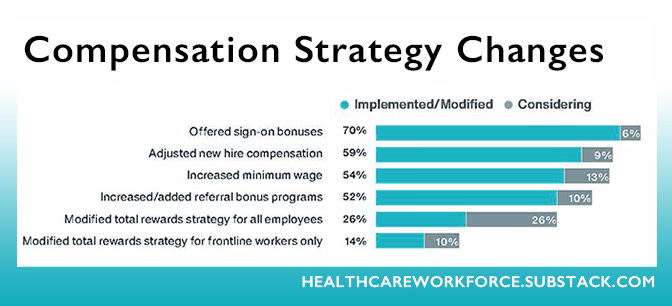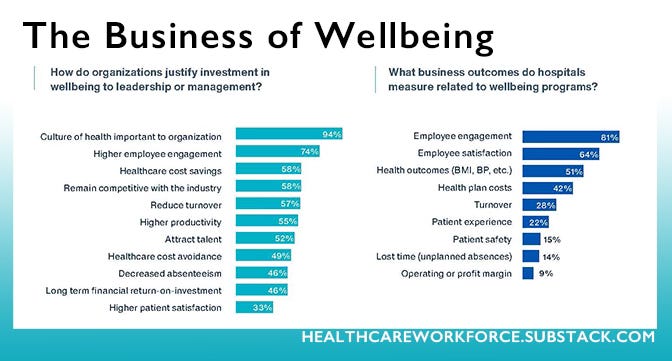Survey: How hospital networks are ramping up retention efforts
Among the top strategies for 2023: sign-on bonuses, more flexibility, more 'premium' benefits, focus on staff wellbeing
Aon’s annual benefits survey of hospital networks, published on Dec. 13, 2023, is chock-full of data showing employers’ top strategies for keeping their existing workforce from leaving.
TLDR: Employers are getting more flexible and creative to better support what workers want in their careers — which is particularly crucial to retention in an era with staffing shortages and inflation that’s been rising faster than salaries.
The research found that 93% of health networks offered flexible work arrangements in 2023, up from 78% in 2022, according to Aon’s research report. Also increasingly popular: more personal leave; more behavioral health benefits; and benefits like financial/wellness planning. Aon also reported that most hospitals are raising their base salary levels.
Becker’s Hospital Review summarized the research with its 5 key findings:
Medical professionals are more likely to leave their hospital jobs during the first three years of employment.
Hospitals reported turnover worsened in 2023 to varying degrees, by job type
62% said nurses were quitting more often than the year before
41% said non-physician clinical positions were quitting more than the year before
22% said physicians left more often in 2023 than the prior 12 months
The most-used tactic for improving recruiting and retention, according to survey respondents, was the introduction of new or higher sign-on bonuses (70%). READ: How health employers can get more bang for their buck and build the talent pool instead of relying on sign-on bonuses.
59% of hospitals said they increased new hire pay
54% upped minimum wage scales
52% increased or added referral bonus programs
Hospitals are upping their benefits game, adding so-called “premium benefits” to keep employees. The list, reported by hospitals responding to Aon’s survey:
95% are offering tuition reimbursement programs
93% are offering more flexible work options, up from 78% in 2022
84% are expanding personal leave, up from 74% the year before
80% are offering financial wellness/planning services as an employee benefit
64% are offering gender-affirming benefits, up from 45% in 2022
57% are offering enhanced behavioral health benefits, up from 40%
53% are lowering the required number of hours to be eligible for benefits
45% are offering paid parental leave beyond state and city mandates
44% are offering student loan repayment plans — and an additional 37% reported this benefit is being considered for 2024
43% are offering a subsidy for adoption
34% are offering back-up childcare
30% are offering expanded fertility coverage beyond the standard medical plan coverage
28% are offering on-site daycare
25% are offering employees subsidies for back-up elder care
Average annual health plan expenses per hospital beneficiary increased 6.7% year over year to $16,151 in 2023.
82% of hospitals said they aim to pay 76% or more of their employees' healthcare costs
13% offer a no-cost health plan option to some segment of their employee population
76% also provide a discount to employees to access the network’s own facilities and providers
Despite all these efforts, health systems surveyed said they “remain concerned about their workforce heading into 2024”; their top concerns include:
89% said access to mental health services
88% said employee burnout/workforce resiliency
85% said offering competitive total rewards to attract and retain talent
85% said increasing healthcare costs for the health system
83% said improving health outcomes
“The top priority for hospitals is to attract and retain front-line medical professionals in the face of a nationwide talent shortage and a surge of demand for medical care after the pandemic,” Sheena Singh, senior vice president of Aon's national healthcare industry practice, said in a news release. “This shortage threatens to impact patient care and accelerate burnout among clinical staff. As a result, health systems have prioritized investment in total rewards and support for workforce resiliency and mental health.”
The firm’s report said hospitals and health networks’ focus “continues to be on the employee and their emotional wellbeing, which replaced physical wellbeing as the most popular focus for programs (since the pandemic started). We have seen the concern for access to mental health providers and employee burnout rise in priority each year, especially since 2020.”
Aon noted that addressing burnout and stress requires cooperation and input from multiple stakeholders within the health system, including human resources, peer-to-peer led programs, administrative and clinical operations, and C-suite roles; as well as support partners to enhance the resources available to the workforce — or help make them more accessible to workers.
Tactics include: a shift in communications strategy; to addressing workflow and administrative efficiency; to expansion of behavioral health networks (both brick-and-mortar and virtual). The responses, like mental health drivers, are not one-size-fits-all.
Communicating the benefits available is equally as crucial as offering them in the first place, Aon said in its executive summary — noting that while 57% of employers surveyed said they believe their “total rewards package is competitive, only 17% believe employees actually understand the value of that package.”
“This leads us to ask how health system employers can better articulate the value of their total rewards package,” Aon said. “This includes a combination of employee listening in the form of surveys and focus groups; modifications to communications strategies; and new channels to distribute information.”
A case of improving nurse satisfaction proving to not be rocket science: the good ol’ buddy system
Becker’s reports that a staff program implemented last year at 6 of 11 hospitals operated by NYC Health + Hospitals is already resulting in lower turnover and improvements in patient care and nurse satisfaction scores.
The “wellbeing buddy” program calls for one staff member on each unit to be designated as a “wellbeing buddy,” tasked with checking in and supporting colleagues.
“Every shift, a nurse or ancillary staff member volunteers for the role, which formalizes their responsibility to promote and protect the team's well-being,” Becker’s reported. “The check-ins can be simple questions asked during the workday — ‘Did you get a lunch break?’ or ‘Do you need water or coffee?’ — but they've led to significant improvements, according to Natalia Cineas, DNP, RN, senior vice president and chief nurse executive of NYC Health + Hospitals.”
“This peer-to-peer check in has been transformational,” she told Becker's. “We all know you have to care for yourself before you care for others. Now that's really ingrained in the culture 24/7. We've seen nurses now singing happy birthday to patients — just the entire milieu has really changed because of the wellbeing buddy.”
Shout-out to Healthcare Workforce Report sponsors
The Healthcare Workforce Report newsletter is generously supported by MedCerts.
For information on supporting HWR, email HealthcareWorkforce@substack.com.








